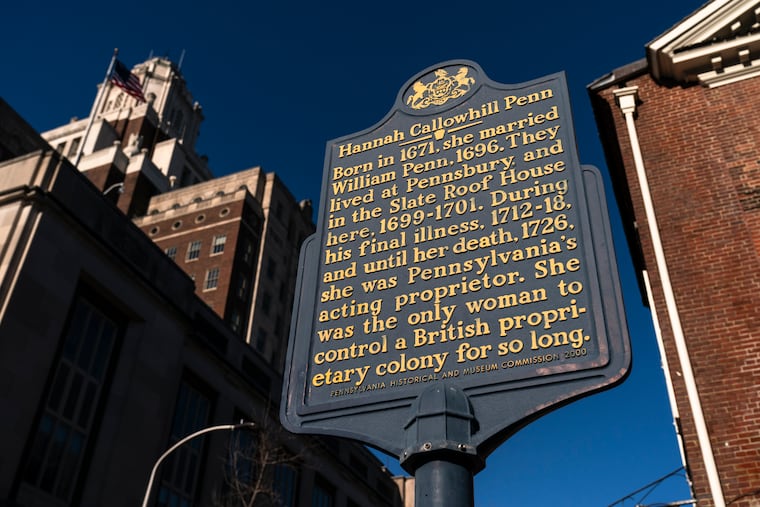What it takes to get a historical marker in Pennsylvania
Philadelphia is home to more than 320 historical markers. Here is how you can nominate a person, place, or event for one.

Some people reach a form of immortality commemorated by a blue and yellow historical marker in the streets of Pennsylvania.
Historical markers immortalize people, places, and events. Pennsylvania has 2,582 markers, with more than 320 of them in Philadelphia. The oldest marker in the city was dedicated in 1932, to John Penn (1729-1795), the last colonial governor of Pennsylvania and William Penn’s grandson.
Intrigued by these plaques, a reader asked Curious Philly, The Inquirer’s forum for questions about the city and region: What does it take to get a historical marker?
This is what it takes, according to the Pennsylvania Historical and Museum Commission’s latest manual.
In Pennsylvania, historical markers recognize people, places, or events nominated by residents or organizations. Then a panel makes recommendations for markers, based on the outlined criteria, to the Pennsylvania Historical and Museum Commission, which ultimately decides who gets a historical marker.
To qualify, you first must be dead. Then, whoever applies has to ready for a bureaucratic process that begins by determining whether you meet the criteria.
There is no limit to how many markers are approved each year, but on average 20 to 25 join the ranks annually, according to the commission.
Who can get a historical marker?
The Historical Marker Program is not a memorial program. It is more about a historical legacy or contribution to the state.
The subject must have a deep connection to Pennsylvania. They don’t need to have been born in the state, but their contribution has to have happened here — this will need to be supported by evidence, publications, letters, and newspaper articles, according to the manual.
People, places, events, and innovations that already have monuments or markers through other programs may get less consideration.
People
Unless the nominee is a Pennsylvania governor or a U.S. president, they must be dead for at least five years. The person must have a deep connection to Pennsylvania, even if they weren’t born here.
In some cases, what might be recognized with the historical marker might not be the individual, but rather what they created.
Take virologist Jonas Salk. He was born in New York but pioneered the University of Pittsburgh’s Virus Research Laboratory, where the world’s first polio vaccine was produced. The discovery led to the virtual eradication of polio in the United States by 1962. Now, the Salk polio vaccine has a historic marker in Allegheny County.
Places
The location must have had an impact on or have been part of history. Did any policies or practices start there? If so, make sure to mention it.
Pennsylvania itself has a marker on Route 15 in Adams County, 200 yards from the state line, proclaiming it as the birthplace of the Declaration of Independence and the Constitution.
Events
Particular historical events can get a marker, but they must have been significant in the context of a larger movement or philosophy.
For example, Cobbs Creek Parkway has a historic marker commemorating the 1985 MOVE bombing, when police dropped a bomb on a West Philly house causing a fire that killed 11 people, including five children, and destroyed 61 homes.
How to apply
Applications can only be done online, through the state historic preservation office website PA-SHARE. An account is required to start the application.
To back up the application, proof of historic significance is needed.
The system allows up to 5,000 characters to explain why the subject has meaning for the state or county, and its connection with Pennsylvania. Additional documents can be added as PDFs.
To add support, the Pennsylvania State Historic Preservation Office recommends:
Three to four supporting documents
Newspaper articles
Letters of support, particularly from experts
A bibliography is needed for the publications and sources that back up the application.
If the application gets denied, you can apply the next year. But, if it’s denied three times in a row, the panel won’t consider it for another three years.
What happens after the application
A statewide five-member panel reviews applications. They vote on their choices and send them to the Pennsylvania Historical and Museum Commission in for consideration. The commission votes and approves the markers.
The bureaucracy doesn’t end here.
Those selected get notified and have additional forms to fill out, including getting signed permission from the location that will house the marker and organizing a dedication ceremony.
The commission has paid for the manufacturing and delivery of the plaques since 2022. But, the applicants are responsible for the costs of installation. In Philly, you must also handle the coordination with the Streets Department.
After all is done and settled, the Pennsylvania Historical and Museum Commission assumes ownership of the historical marker. But if the marker is not installed within two years, the process must be started all over again.